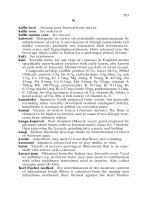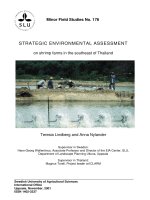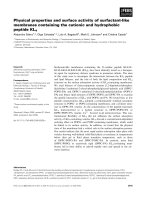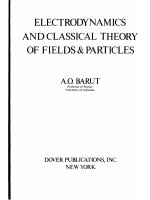EXTENT OF CANALIZATION AND SURFACE FITTING OF FIELDS docx
Bạn đang xem bản rút gọn của tài liệu. Xem và tải ngay bản đầy đủ của tài liệu tại đây (134.68 KB, 16 trang )
EXTENT OF CANALIZATION AND
SURFACE FITTING OF FIELDS
On the evening of March 15th we left Canton for Hongkong and the
following day embarked again on the Tosa Maru for Shanghai. Although
our steamer stood so far to sea that we were generally out of sight
of land except for some off-shore islands, the water was turbid most
of the way after we had crossed the Tropic of Cancer off the mouth
of the Han river at Swatow. Over a sea bottom measuring more than
six hundred miles northward along the coast, and perhaps fifty miles
to sea, unnumbered acre-feet of the richest soil of China are being
borne beyond the reach of her four hundred millions of people and
the children to follow them. Surely it must be one of the great
tasks of future statesmanship, education and engineering skill to
divert larger amounts of such sediments close along inshore in such
manner as to add valuable new land annually to the public domain,
not alone in China but in all countries where large resources of
this type are going to waste.
In the vast Cantonese delta plains which we had just left, in the
still more extensive ones of the Yangtse kiang to which we were now
going, and in those of the shifting Hwang ho further north,
centuries of toiling millions have executed works of almost
incalculable magnitude, fundamentally along such lines as those just
suggested. They have accomplished an enormous share of these tasks
by sheer force of body and will, building levees, digging canals,
diverting the turbid waters of streams through them and then
carrying the deposits of silt and organic growth out upon the
fields, often borne upon the shoulders of men in the manner we have
seen.
It is well nigh impossible, by word or map, to convey an adequate
idea of the magnitude of the systems of canalization and delta and
other lowland reclamation work, or of the extent of surface fitting
of fields which have been effected in China, Korea and Japan through
the many centuries, and which are still in progress. The lands so
reclaimed and fitted constitute their most enduring asset and they
support their densest populations. In one of our journeys by
houseboat on the delta canals between Shanghai and Hangchow, in
China, over a distance of 117 miles, we made a careful record of the
number and dimensions of lateral canals entering and leaving the
main one along which our boat-train was traveling. This record shows
that in 62 miles, beginning north of Kashing and extending south to
Hangchow, there entered from the west 134 and there left on the
coast side 190 canals. The average width of these canals, measured
along the water line, we estimated at 22 and 19 feet respectively on
the two sides. The height of the fields above the water level ranged
from four to twelve feet, during the April and May stage of water.
The depth of water, after we entered the Grand Canal, often exceeded
six feet and our best judgment would place the average depth of all
canals in this part of China at more than eight feet below the level
of the fields.
In Fig. 51, representing an area of 718 square miles in the region
traversed, all lines shown are canals, but scarcely more than
one-third of those present are shown on the map. Between A, where we
began our records, before reaching Kashing, and B, near the left
margin of the map, there were forty-three canals leading in from the
up-country side, instead of the eight shown, and on the coast side
there were eighty-six leading water out into the delta plain toward
the coast, instead of the twelve shown. Again, on one of our trips
by rail, from Shanghai to Nanking, we made a similar record of the
number of canals seen from the train, close along the track, and the
notes show, in a distance of 162 miles, 593 canals between Lungtan
and Nansiang. This is an average of more than three canals per mile
for this region and that between Shanghai and Hangchow.
The extent, nature and purpose of these vast systems of internal
improvement may be better realized through a study of the next two
sketch maps. The first, Fig. 52, represents an area 175 by 160
miles, of which the last illustration is the portion enclosed in the
small rectangle. On this area there are shown 2,700 miles of canals
and only about one-third of the canals shown in Fig. 51 are laid
down on this map, and according to our personal observations there
are three times as many canals as are shown on the map of which Fig.
51 represents a part. It is probable, therefore, that there exists
today in the area of Fig. 52 not less than 25,000 miles of canals.
In the next illustration, Fig. 53, an area of northeast China, 600
by 725 miles, is represented. The unshaded land area covers nearly
200,000 square miles of alluvial plain. This plain is so level that
at Ichang, nearly a thousand miles up the Yangtse, the elevation is
only 130 feet above the sea. The tide is felt on the river to beyond
Wuhu, 375 miles from the coast. During the summer the depth of water
in the Yangtse is sufficient to permit ocean vessels drawing
twenty-five feet of water to ascend six hundred miles to Hankow, and
for smaller steamers to go on to Ichang, four hundred miles further.
The location, in this vast low delta and coastal plain, of the
system of canals already described, is indicated by the two
rectangles in the south-east corner of the sketch map, Fig. 53. The
heavy barred black line extending from Hangchow in the south to
Tientsin in the north represents the Grand Canal which has a length
of more than eight hundred miles. The plain, east of this canal, as
far north as the mouth of the Hwang ho in 1852, is canalized much as
is the area shown in Fig. 52. So, too, is a large area both sides of
the present mouth of the same river in Shantung and Chihli, between
the canal and the coast. Westward, up the Yangtse valley, the
provinces of Anhwei, Kiangsi, Hunan and Hupeh have very extensive
canalized tracts, probably exceeding 28,000 square miles in area,
and Figs. 54 and 55 are two views in this more western region. Still
further west, in Szechwan province, is the Chengtu plain, thirty by
seventy miles, with what has been called "the most remarkable
irrigation system in China."
Westward beyond the limits of the sketch map, up the Hwang ho
valley, there is a reach of 125 miles of irrigated lands about
Ninghaifu, and others still farther west, at Lanchowfu and at Suchow
where the river has attained an elevation of 5,000 feet, in Kansu
province; and there is still to be named the great Canton delta
region. A conservative estimate would place the miles of canals and
leveed rivers in China, Korea and Japan equal to eight times the
number represented in Fig. 52. Fully 200,000 miles in all. Forty
canals across the United States from east to west and sixty from
north to south would not equal, in number of miles those in these
three countries today. Indeed, it is probable that this estimate is
not too large for China alone.
As adjuncts to these vast canalization works there have been
enormous amounts of embankment, dike and levee construction. More
than three hundred miles of sea wall alone exist in the area covered
by the sketch map, Fig. 52. The east bank of the Grand Canal,
between Yangchow and Hwaianfu, is itself a great levee, holding back
the waters to the west above the eastern plain, diverting them
south, into the Yangtse kiang. But it is also provided with
spillways for use in times of excessive flood, permitting waters to
discharge eastward. Such excess waters however are controlled by
another dike with canal along its west side, some forty miles to the
east, impounding the water in a series of large lakes until it may
gradually drain away. This area is seen in Fig. 53, north of the
Yangtse river.
Along the banks of the Yangtse, and for many miles along the Hwang
ho, great levees have been built, some-times in reinforcing series
of two or three at different distances back from the channel where
the stream bed is above the adjacent country, in order to prevent
widespread disaster and to limit the inundated areas in times of
unusual flood. In the province of Hupeh, where the Han river flows
through two hundred miles of low country, this stream is diked on
both sides throughout the whole distance, and in a portion of its
course the height of the levees reaches thirty feet or more. Again,
in the Canton delta region there are other hundreds of miles of sea
wall and dikes, so that the aggregate mileage of this type of
construction works in the Empire can only be measured in thousands
of miles.
In addition to the canal and levee construction works there are
numerous impounding reservoirs which are brought into requisition to
control overflow waters from the great streams. Some of these
reservoirs, like Tungting lake in Hupeh and Poyang in Hunan, have
areas of 2,000 and 1,800 square miles respectively and during the
heaviest rainy seasons each may rise through twenty to thirty feet,
Then there are other large and small lakes in the coastal plain
giving an aggregate reservoir area exceeding 13,000 square miles,
all of which are brought into service in controlling flood waters,
all of which are steadily filling with the sediments brought from
the far away uncultivable mountain slopes and which are ultimately
destined to become rich alluvial plains, doubtless to be canalized
in the manner we have seen.
There is still another phase of these vast construction works which
has been of the greatest moment in increasing the maintenance
capacity of the Empire, the wresting from the flood waters of the
enormous volumes of silt which they carry, depositing it over the
flooded areas, in the canals and along the shores in such manner as
to add to the habitable and cultivable land. Reference has been made
to the rapid growth of Chungming island in the mouth of the Yangtse
kiang, and the million people now finding homes on the 270 square
miles of newly made land which now has its canals, as may be seen in
the upper margin of Fig. 52. The city of Shanghai, as its name
signifies, stood originally on the seashore, which has now grown
twenty miles to the northward and to the eastward. In 220 B. C. the
town of Putai in Shantung stood one-third of a mile from the sea,
but in 1730 it was forty-seven miles inland, and is forty-eight
miles from the shore today.
Sienshuiku, on the Pei ho, stood upon the seashore in 500 A. D. We
passed the city, on our way to Tientsin, eighteen miles inland. The
dotted line laid in from the coast of the Gulf of Chihli in Fig. 53
marks one historic shore line and indicates a general growth of land
eighteen miles to seaward.
Besides these actual extensions of the shore lines the centuries of
flooding of lakes and low lying lands has so filled many depressions
as to convert large areas of swamp into cultivated fields. Not only
this, but the spreading of canal mud broadcast over the encircled
fields has had two very important effects, namely, raising the
level of the low lying fields, giving them better drainage and so
better physical condition, and adding new plant food in the form of
virgin soil of the richest type, thus contributing to the
maintenance of soil fertility, high maintenance capacity and
permanent agriculture through all the centuries.
These operations of maintenance and improvement had a very early
inception; they appear to have persisted throughout the recorded
history of the Empire and are in vogue today. Canals of the type
illustrated in Figs. 51 and 52 have been built between 1886 and
1901, both on the extensions of Chungming island and the newly
formed main land to the north, as is shown by comparison of
Stieler's atlas, revised in 1886, with the recent German survey.
Earlier than 2255 B. C., more than 4100 years ago, Emperor Yao
appointed "The Great" Yu "Superintendent of Works" and entrusted him
with the work of draining off the waters of disastrous floods and of
canalizing the rivers, and he devoted thirteen years to this work.
This great engineer is said to have written several treatises on
agriculture and drainage, and was finally called, much against his
wishes, to serve as Emperor during the last seven years of his life.
The history of the Hwang ho is one of disastrous floods and
shiftings of its course, which have occurred many times in the years
since before the time of the Great Yu, who perhaps began the works
perpetuated today. Between 1300 A. D. and 1852 the Hwang ho emptied
into the Yellow Sea south of the highlands of Shantung, but in that
year, when in unusual flood, it broke through the north levees and
finally took its present course, emptying again into the Gulf of
Chihli, some three hundred miles further north. Some of these
shiftings of course of the Hwang ho and of the Yangtse kiang are
indicated in dotted lines on the sketch map, Fig. 53, where it may
he seen that the Hwang ho during 146 years, poured its waters into
the sea as far north as Tientsin, through the mouth of the Pei ho,
four hundred miles to the northward of its mouth in 1852.
This mighty river is said to carry at low stage, past the city of
Tsinan in Shantung, no less than 4,000 cubic yards of water per
second, and three times this volume when running at flood. This is
water sufficient to inundate thirty-three square miles of level
country ten feet deep in twenty-four hours. What must be said of the
mental status of a people who for forty centuries have measured
their strength against such a Titan racing past their homes above
the level of their fields, confined only between walls of their own
construction? While they have not always succeeded in controlling
the river, they have never failed to try again. In 1877 this river
broke its banks, inundating a vast. area, bringing death to a
million people. Again, as late as 1898, fifteen hundred villages to
the northeast of Tsinan and a much larger area to the southwest of
the same city were devastated by it, and it is such events as these
which have won for the river the names "China's Sorrow," "The
Ungovernable" and "The Scourge of the Sons of Han."
The building of the Grand Canal appears to have been a comparatively
recent event in Chinese history. The middle section, between the
Yangtse and Tsingkiangpu, is said to have been constructed about the
sixth century B. C.; the southern section, between Chingkiang and
Hangchow, during the years 605 to 617 A. D.; but the northern
section, from the channel of the Hwang ho deserted in 1852, to
Tientsin, was not built until the years 1280-1283.
While this canal has been called by the Chinese Yu ho (Imperial
river), Yun ho (Transport river) or Yunliang ho (Tribute bearing
river) and while it has connected the great rivers coming down from
the far interior into a great water-transport system, this feature
of construction may have been but a by-product of the great
dominating purpose which led to the vast internal improvements in
the form of canals, dikes, levees and impounding reservoirs so
widely scattered, so fully developed and so effectively utilized.
Rather the master purpose must have been maintenance for the
increasing flood of humanity. And I am willing to grant to the Great
Yu, with his finger on the pulse of the nation, the power to project
his vision four thousand years into the future of his race and to
formulate some of the measures which might he inaugurated to grow
with the years and make certain perpetual maintenance for those to
follow.
The exhaustion of cultivated fields must always have been the most
fundamental, vital and difficult problem of all civilized people and
it appears clear that such canalization as is illustrated in Figs.
51 and 52 may have been primarily initial steps in the reclamation
of delta and overflow lands. At any rate, whether deliberately so
planned or not, the canalization of the delta and overflow plains of
China has been one of the most fundamental and fruitful measures for
the conservation of her national resources that they could have
taken, for we are convinced that this oldest nation in the world has
thus greatly augmented the extension of its coastal plains,
conserving and building out of the waste of erosion wrested from the
great streams, hundreds of square miles of the richest and most
enduring of soils, and we have little doubt that were a full and
accurate account given of human influence upon the changes in this
remarkable region during the last four thousand years it would show
that these gigantic systems of canalization have been matters of
slow, gradual growth, often initiated and always profoundly
influenced by the labors of the strong, patient, persevering,
thoughtful but ever silent husband-men in their efforts to acquire
homes and to maintain the productive power of their fields.
Nothing appears more clear than that the greatest material problem
which can engage the best thought of China today is that of
perfecting, extending and perpetuating the means for controlling her
flood waters, for better draining of her vast areas of low land, and
for utilizing the tremendous loads of silt borne by her streams more
effectively in fertilizing existing fields and in building and
reclaiming new land. With her millions of people needing homes and
anxious for work; who have done so much in land building, in
reclamation and in the maintenance of soil fertility, the government
should give serious thought to the possibility of putting large
numbers of them at work, effectively directed by the best
engineering skill. It must now be entirely practicable, with
engineering skill and mechanical appliances, to put the Hwang ho,
and other rivers of China subject to overflow, completely under
control. With the Hwang ho confined to its channel, the adjacent low
lands can be better drained by canalization and freed from the
accumulating saline deposits which are rendering them sterile.
Warping may be resorted to during the flood season to raise the
level of adjacent low-lying fields, rendering them at the same time
more fertile. Where the river is running above the adjacent plains
there is no difficulty in drawing off the turbid water by gravity,
under controlled conditions, into diked basins, and even in
compelling the river to buttress its own levees. There is certainly
great need and great opportunity for China to make still better and
more efficient her already wonderful transportation canals and those
devoted to drainage, irrigation and fertilization.
In the United States, along the same lines, now that we are
considering the development of inland waterways, the subject should
be surveyed broadly and much careful study may well be given to the
works these old people have developed and found serviceable through
so many centuries. The Mississippi is annually bearing to the sea
nearly 225,000 acre-feet of the most fertile sediment, and between
levees along a raised bed through two hundred miles of country
subject to inundation. The time is here when there should he
undertaken a systematic diversion of a large part of this fertile
soil over the swamp areas, building them into well drained,
cultivable, fertile fields provided with waterways to serve for
drainage, irrigation, fertilization and transportation. These great
areas of swamp land may thus be converted into the most productive
rice and sugar plantations to be found anywhere in the world, and
the area made capable of maintaining many millions of people as long
as the Mississippi endures, bearing its burden of fertile sediment.
But the conservation and utilization of the wastes of soil erosion,
as applied in the delta plain of China, stupendous as this work has
been, is nevertheless small when measured by the savings which
accrue from the careful and extensive fitting of fields so largely
practiced, which both lessens soil erosion and permits a large
amount of soluble and suspended matter in the run-off to be applied
to, and retained upon, the fields through their extensive systems of
irrigation. Mountainous and hilly as are the lands of Japan, 11,000
square miles of her cultivated fields in the main islands of Honshu,
Kyushu and Shikoku have been carefully graded to water level areas
bounded by narrow raised rims upon which sixteen or more inches of
run-off water, with its suspended and soluble matters, may be
applied, a large part of which is retained on the fields or utilized
by the crop, while surface erosion is almost completely prevented.
The illustrations, Figs. 11, 12 and 13 show the application of the
principle to the larger and more level fields, and in Figs. 151, 152
and 225 may be seen the practice on steep slopes.
If the total area of fields graded practically to a water level in
Japan aggregates 11,000 square miles, the total area thus surface
fitted in China must be eight or tenfold this amount. Such enormous
field erosion as is tolerated at the present time in our southern
and south Atlantic states is permitted nowhere in the Far East, so
far as we observed, not even where the topography is much steeper.
The tea orchards as we saw them on the steeper slopes, not
level-terraced, are often heavily mulched with straw which makes
erosion, even by heavy rains impossible, while the treatment retains
the rain where it falls, giving the soil opportunity to receive it
under the impulse of both capillarity and gravity, and with it the
soluble ash ingredients leached from the straw. The straw mulches we
saw used in this manner were often six to eight inches deep, thus
constituting a dressing of not less than six tons per acre, carrying
140 pounds of soluble potassium and 12 pounds of phosphorus. The
practice, therefore, gives at once a good fertilizing, the highest
conservation and utilization of rainfall, and a complete protection
against soil erosion. It is a multum in parvo treatment which
characterizes so many of the practices of these people, which have
crystallized from twenty centuries of high tension experience.
In the Kiangsu and Chekiang provinces as elsewhere in the densely
populated portions of the Far East, we found almost all of the
cultivated fields very nearly level or made so by grading. Instances
showing the type of this grading in a comparatively level country
are seen in Figs. 56 and 57. By this preliminary surface fitting of
the fields these people have reduced to the lowest possible limit
the waste of soil fertility by erosion and surface leaching. At the
same time they are able to retain upon the field, uniformly
distributed over it, the largest part of the rainfall practicable,
and to compel a much larger proportion of the necessary run off to
leave by under-drainage than would be possible otherwise, conveying
the plant food developed in the surface soil to the roots of the
crops, while they make possible a more complete absorption and
retention by the soil of the soluble plant food materials not taken
up. This same treatment also furnishes the best possible conditions
for the application of water to the fields when supplemental
irrigation would be helpful, and for the withdrawal of surplus
rainfall by surface drainage, should this be necessary.
Besides this surface fitting of fields there is a wide application
of additional methods aiming to conserve both rainfall and soil
fertility, one of which is illustrated in Fig. 58, showing one end
of a collecting reservoir. There were three of these reservoirs in
tandem, connected with each other by surface ditches and with an
adjoining canal. About the reservoir the level field is seen to be
thrown into beds with shallow furrows between the long narrow
ridges. The furrows are connected by a head drain around the margin
of the reservoir and separated from it by a narrow raised rim. Such
a reservoir may be six to ten feet deep but can be completely
drained only by pumping or by evaporation during the dry season.
Into such reservoirs the excess surface water is drained where all
suspended matter carried from the field collects and is returned,
either directly as an application of mud or as material used in
composts. In the preparation of composts, pits are dug near the
margin of the reservoir, as seen in the illustration, and into them
are thrown coarse manure and any roughage in the form of stubble or
other refuse which may be available, these materials being saturated
with the soft mud dipped from the bottom of the reservoir.
In all of the provinces where canals are abundant they also serve as
reservoirs for collecting surface washings and along their banks
great numbers of compost pits are maintained and repeatedly filled
during the season, for use on the fields as the crops are changed.
Fig. 59 shows two such pits on the bank of a canal, already filled.
In other cases, as in the Shantung province, illustrated in Fig. 60,
the surface of the field may be thrown into broad leveled lands
separated and bounded by deep and wide trenches into which the
excess water of very heavy rains may collect. As we saw them there
was no provision for draining the trenches and the water thus
collected either seeps away or evaporates, or it may be returned in
part by underflow and capillary rise to the soil from which it was
collected, or be applied directly for irrigation by pumping. In this
province the rains may often be heavy but the total fall for the
year is small, being little more than twenty-four inches hence there
is the greatest need for its conservation, and this is carefully
practiced.









